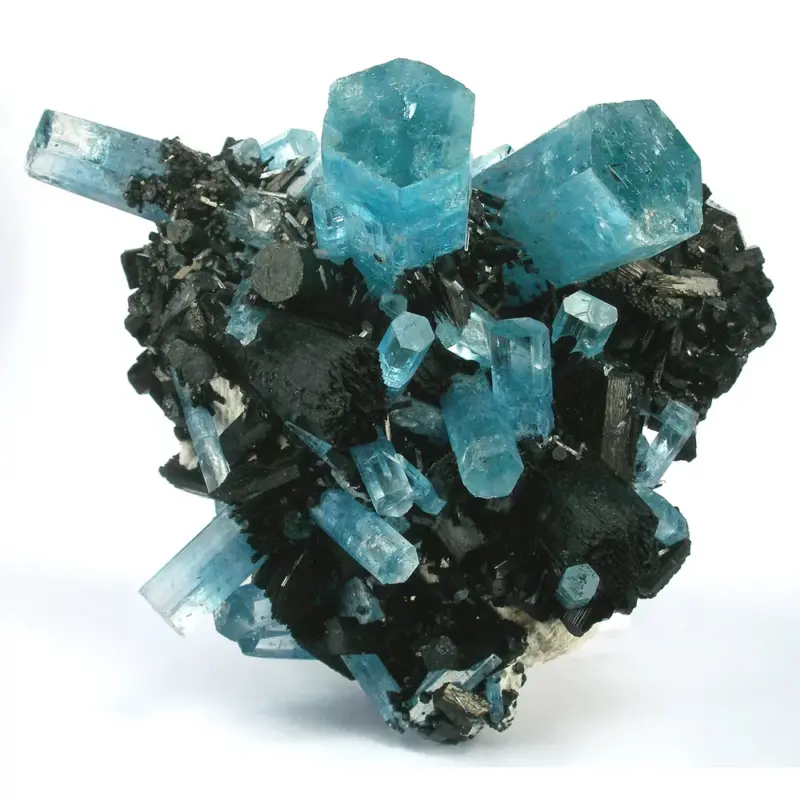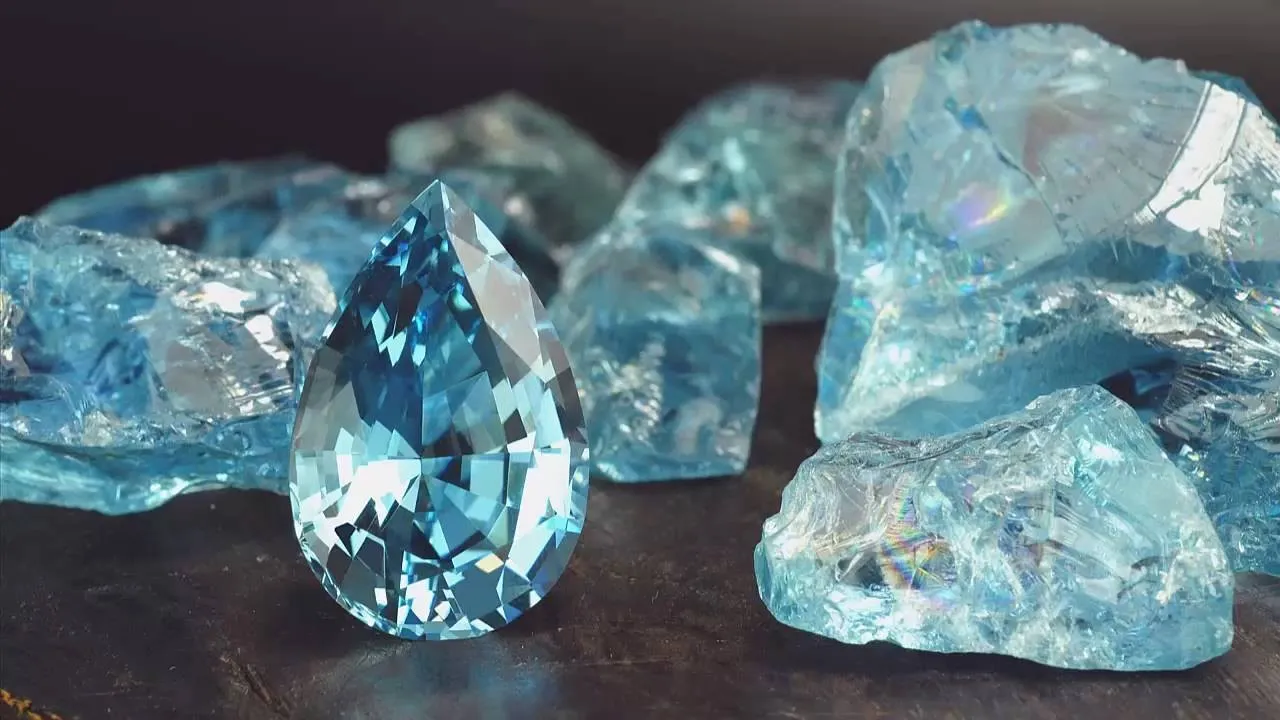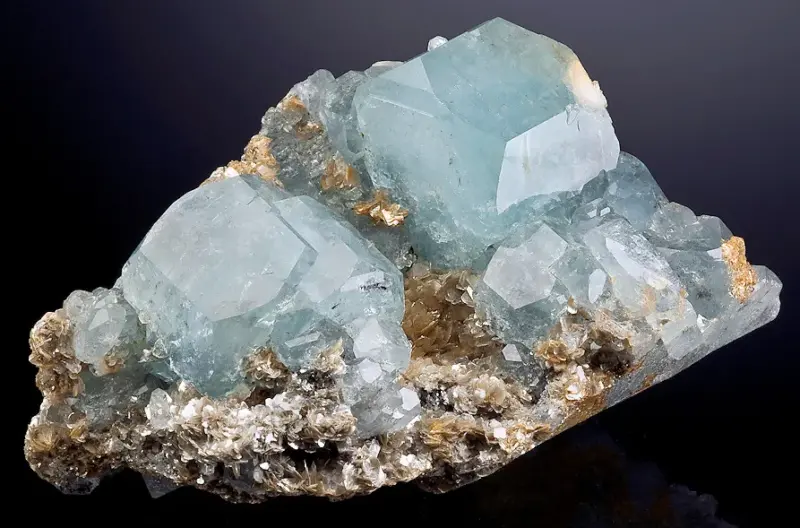Aquamarine Stone is a captivating gemstone known for its fascinating blue colour, making it a popular choice for gemstone collectors and jewellery enthusiasts alike.
Aquamarine Stone is also a popular gemstone for use in jewellery and is the Stone of the Month for March.
Like aquamarine, emerald, heliodor and morganite are variations of beryl.
Beryls are usually found with a special glassy, transparent lustre. The pure stone is colourless, but due to the hues of other elements it can appear in blue, yellow, red, white and green.

It is highly prized for its stunning blue to blue-green colour, reminiscent of the clear waters of the sea, hence the name ‘aquamarine’ (aqua means water and marine means sea).
The colour of aquamarine comes from traces of iron in the stone.
Aquamarine is typically blue-green in nature, so it is heat-treated to remove the yellow component and produce a true blue colour.
Brazil is one of the major sources of aquamarine.
The state of Minas Gerais is particularly well known for its aquamarine deposits. The Jequitinhonha Valley and the famous mines in the Teófilo Otoni region are famous for their high quality aquamarine crystals.
The stone is found in various locations around the world, including Brazil, Madagascar, Nigeria, Zambia, Pakistan and Russia.
Quality and colour can vary depending on the source.
The gemstone can be transparent to translucent, with higher quality stones being more transparent.

Como diferenciar topázio de água marinha
See also Emeraldstone – characteristics, types and quality.
Symbolism and Meaning
Aquamarine Stone has been associated with various symbolic meanings throughout history. It is often seen as a symbol of youth, hope and eternal life. It is also believed to promote calm, clarity and emotional balance.
Its uses
Aquamarine’s main use is as a gemstone in jewellery.
It is cut and polished into various shapes to be set in rings, earrings, necklaces and bracelets. Aquamarine’s beauty and popularity make it a highly sought after gemstone in the jewellery industry.
Names used by the market
- Madagascar aquamarine – mid blue
- Brazilian aquamarine – bluish green and greenish blue
Care and Maintenance
Aquamarine is relatively durable, but it can still be susceptible to scratches and damage from rough handling or hard blows.
The best way to care for your aquamarine jewellery is to store it away from other gemstones to avoid scratches.
It can be cleaned with warm soapy water and a soft brush. Ultrasonic cleaners are generally safe for aquamarine, but it’s best to consult a professional jeweller for specific cleaning recommendations.

Characteristics of Aquamarine Stone
1. Colour
Aquamarine is known for its captivating blue to blue-green colour. The hue can vary from a pale, light blue to deeper, more vibrant tones reminiscent of the colours of the sea.
The colour is caused by traces of iron in the structure of the crystal.
2. Transparency
The stone is usually transparent to translucent. High quality Aquamarine gemstones tend to be more transparent, allowing light to pass through the crystal with minimal obstruction.
3. Crystal system
Aquamarine crystallises in the hexagonal crystal system. It forms prismatic crystals with a hexagonal cross section. These crystals usually have vertically striated faces and can vary in size from small to large.
4. Hardness
Hardness of 7.5 to 8 on the Mohs scale. This is relatively high on the scale and indicates good durability. However, it is important to note that hardness refers to a mineral’s resistance to scratching, not its toughness or resistance to breaking.
5. Fractures
Aquamarine has little or no cleavage. Cleavage refers to the tendency of a mineral to fracture along certain planes of weakness. In the case of aquamarine, it breaks unevenly and exhibits a conchoidal or shell fracture.
6. Lustre
Crystal has a glassy to resinous lustre. When properly cut and polished, it can have a brilliant lustre and a glassy sheen.
7. Identification features
Relatively free of inclusions; hollow or fluid-filled growth tubes parallel to the c-axis of the crystal (“rain effect”); radially arranged fluid droplets (“snow star” or “chrysanthemum”) and, less commonly, mineral inclusions (iron oxide).
8. Possible treatments
Blue-green specimens turn blue (removal of the yellow colour component or centre) by heat treatment at temperatures between approximately 400 and 450ºC (stable, irreversible).

The heated half of the stone now has the Agua Marinha blue colour that most people are used to seeing. The stone has been heated to 400°C for an hour or more.
9. Possible mix-ups
Blue topaz, synthetic blue spinel, synthetic blue quartz and maxixe beryl (a type of beryl treated by irradiation).
Publicações Relacionadas
Ruby Stone - Characteristics, Colours and Cutting
Characteristics of the Paraíba Tourmaline, a rare gemstone
Tiger Eye Stone - Characteristics and Cutting
Pindobaçu (BA), known as the capital of emeralds
Sapphire is the purity of nature and a symbol of honesty
Emerald Stone - Characteristics, varieties and quality
Tourmaline: Learn about its characteristics and varieties
Characteristics of Topaz and Imperial Topaz gemstones
The malachite stone is a distinctive gemstone - Features
Agate Stone - Characteristics, Types, Colour and Cutting
Identifying a gem is a difficult task
Jade stone - characteristics, colour, classification and cutting
Opala é uma das mais belas pedras preciosas encontradas no Brasil
Quartz Stone - Characteristics, Colours and Varieties
Diamonds have 4 basic classifications, weight, colour, purity and cut
Jewellery made from different types of coral - Features
Amethyst stone - characteristics, marketing and valuation
This post is also on:
![]() Português
Português ![]() English
English ![]() Deutsch
Deutsch ![]() Español
Español ![]() Français
Français



















